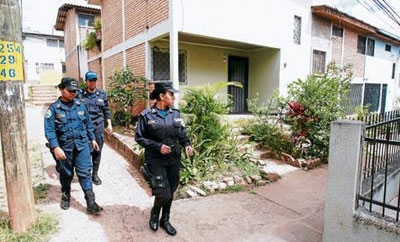Community policing programs in Honduras are beginning to show results, with violence rates decreasing in some areas where they have been put in place, though judicial reform will also be necessary to cut the country’s high rate of crime.
The Tegucigalpa neighbourhood of La Joya received its first community police unit in September 2011, as El Heraldo reported.
One year on from the inauguration, the project appears to be delivering results. According to a new report by InforSurHoy, crime rates have dropped across the board, and Inspector Sandra Cabrera, who heads the La Joya community police unit, told the news source that the turn-around was immediate. “Last year there were more than 20 armed assaults, three murders and the constant presence of extortionists,” while in 2012 there have been no murders or extortions and only three armed assaults reported, she said.
The results have been replicated in other parts of Tegucigalpa where community police operations have been put in place. In January, a unit began working in the neighbourhood of Flor del Campo, which InfoSurHoy refers to as “one of the most dangerous settlements in the Honduran capital.” Since then, only three homicides have been reported, compared to 32 last year.
The community policing project, which has been in development since 2008 and has support from the Brazilian government, is not confined to the capital. Currently, there are 250 community police officers working with some 50,000 volunteers throughout the country to offer cultural events for communities, organize safety committees and develop drug and gang prevention initiatives, InfoSurHoy states.
Milton Funez, deputy inspector of the Flor del Campo unit, told InfoSurHoy, “By becoming closer to the people we are reversing the bad image the National Police had, and we are also showing our peers we can work for a better country.”
InSight Crime Analysis
Similar community policing initiatives have been implemented in other parts of the region. The most famous of these is Rio de Janeiro’s “pacification” program, launched in 2008, which has seen some of the city’s favelas receive community-focused police pacification units (UPPs). These are meant to install a permanent police presence in areas that have been abandoned by the state, rather than just conducting police raids against gangs operating in the areas. A study funded by the CAF development bank, released in July, found that the UPPs had reduced violence in the neighborhoods where they have been installed.
Guatemala has had a US-funded “model precinct” program in place in parts of the country since 2004, which focuses on preventative policing, and training officers to strengthen their ties with the community. In a recent report, International Crisis Group said that these programs had the potential to improve policing, though it remained to be seen if they could be replicated across the country, or if they would remain what one Guatemalan official called “archipelagos of competence in a sea of corruption.” Crisis Group reported that there had been success in the scheme in Mixco municipality which neighbors the capital, though results have been more mixed in Villa Nueva, to the south.
However, despite the early signs of success in Honduras, the community police units must still work in conjunction with the National Police, and indirectly with the judicial system, both of which are notoriously corrupt. Impunity hovers around 90 percent in the country, and some elements in the police force are known to work with criminal gangs.
There is a limit to how much community policing can do to prevent crime, given that Honduras remains a primary transit point for US-bound cocaine and has a strong presence of Central America’s “mara” gangs. Efforts to tackle corruption in the police and judiciary must therefore be made a priority, as well as community policing initiatives.

